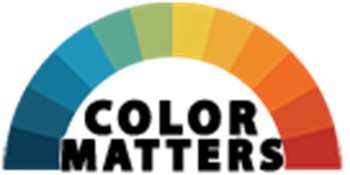A color trend is a direction. It’s a developing awareness or an emerging preference for a color or several colors. Therefore, a color trend can change the way we think about a color and how we purchase consumer goods. In short, we constantly communicate via the medium of color.
Here’s another way to define a trend:
“A fad is a flash-in-the pan, a trend is something with a little more practicality and purpose, and a style is something that continually re-invents itself over time to become a classic." - Linda DeFranco,
The Psychology of Color Trends
The novelty of a color creates a desire for the color. Typically, an emerging color is quite different from what preceded it. Following a trend is an opportunity to experience something fresh and exciting. Variety is the spice of life. Perhaps this explains why we welcome a new color and why this generates consumer activity.
Color Trends: The Power of Media
The foundation for the emergence of color trends is the access to information and colored images. Prior to today’s era of film, television, the Internet and smartphones, people did not have immediate access to color images. Up until the 20th century, printed material - such as books and magazines - and artwork in museums and churches were the only media for the distribution of images and information. Furthermore, humanity was more intent on survival than purchasing fashionable items. Consumer culture didn’t become a reality until after WWII.
A Historical Perspective of Color Trends
Prior to the year 2000, trends were slower to materialize and lasted longer.
The 19th Century
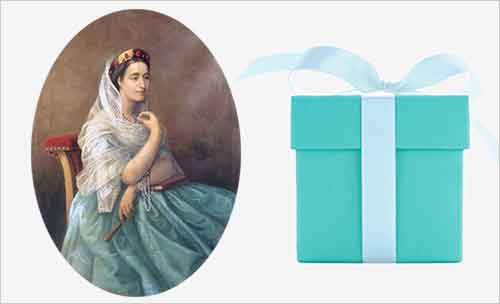
Royalty and rulers, celebrities and artists were the trendsetters in the 19th century.
Examples
The signature color of Napoleon’s wife, Empress Eugenie de Montijo was light turquoise, which was just a shade different than the woman she she most admired, Marie Antoinette. Tiffany chose the favorite color of this royal celebrity for its iconic robin’s egg blue boxes in 1837.
The white wedding dress trend began in 1840 when Queen Victoria selected a white dress, which was considered an unusual choice at a time when colors were more usual,
In 1870s Paris, the old, academic art establishments were obsessed with the color violet.
The 20th Century
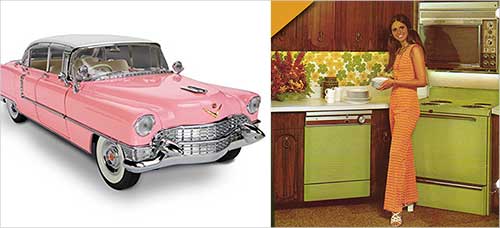
In the 20th century, we influenced color trends as much as they influenced us. Colors that gained traction - whether used in fashion, paint, or furnishings - reflected what was happening in the wider world. For example, the rise of a color could be connected to subtler elements, such as changes in the country's economic or cultural climate.
Examples
Although the Women's Institute for Domestic Science in the U.S. endorsed pink for boys, blue for girls in 1921. Twenty-five years later, the “trend” was reversed and the tradition of pink for girls and blue for boys was firmly established.
The popularity of light-hearted pastels of the 1950s contrasted with the somber colors of previous years that were marked by World Wars and the depression. For example, pink Cadillac’s (1955) and turquoise refrigerators. Psychedelic colors emerged in the 60s as Rock ‘n Roll turned people on to color.
The recession of the 1970s brought a retreat into safe, sober, earth colors. Avocado green, harvest gold, and burnt orange colored the worlds of fashion and appliances in the 70s.
The economic upturn of the 80s brought bold colors, and black and white. Graffiti and artists like Keith Haring, captured the vibes of the time in red, blue, green and yellow. At the same time, colors such as dusty rose (mauve), became a popular for interior design.
The economic downturn at the end of the 80s led to the “dirtied” grunge colors of the early 90s. By the mid 90s, the bold colors of the iMac, urban street style, and minimalism influenced color trends.
Color Trends in the 21st Century

At the turn of the 21st century, we found ourselves immersed in a world of information unlike any time in the history of humanity. Global access to the Internet in the late 20th century was followed by media feeds on the smartphone. Today, we’re subject to an overflow of input from film, television, fashion, socio-political events, designers, celebrities, and forecasting agencies that proclaim a “Color of the Year.” Just google “color trends” and you’ll get 13,700,000 results.
In fact, we see more images in one day than our ancestors in the Middle Ages saw in a lifetime.
Furthermore, there are trends for every industry sector. There might be one set of colors for the automotive industry and quite a different set of colors in fashion or interior design. For example, matte black stainless steel may be the new trend for home appliances or smartphones, but it may not have any effect on sportswear apparel.
Of even greater significance is that different cultures, geographic regions, genders, and age groups may embrace unique trends and may react differently to “global trends.” Consequently, the diversity of color trends is as great as the media that influences them.
Unfortunately, a brief summary of the most significant trends of the 21st century is an impossible task. The complexity of these trends would require an analysis based on industry sectors and demographic parameters (age, culture, region, etc.). Therefore, this would fill an entire book.
Note: The best way to pinpoint these trends is to google “color trends _____” and fill in the year. You might be amazed at the results.
A few words from Color Matters author, Jill Morton
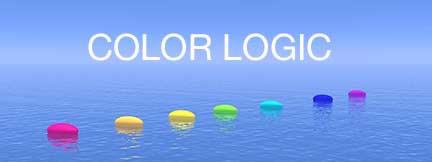
Color logic is practical color. It's a timeless tool for all designers. Check out the online courses at the Color Matters Design Academy.
Color Forecasters
Since the turn of the century, trend forecasting has become big business. There are organizations such as the Color Marketing Group (CMG), the Color Association of the United States (CAUS) and the International Colour Authority (ICA). Add to this list the agencies that focus on specific regions such as China or the Middle East. See this list.
Color of the Year
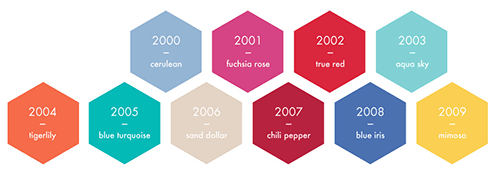
Forecasting a single color for one year brings into play the paint companies who name an “it” color. And then there’s Pantone (a manufacturer of color chips & color matching tools) who has chosen a “Color of the Year” for every year since 2000.
In short, Pantone chooses a color that reflects the current cultural climate. In the following year, the color influences trends interior décor, fashion, food, and other facets of design. However, the color of the year doesn’t apply to every brand or product. For example, the color may or may not be appropriate for towels, tennis shoes, or SUVs.
Color forecasters' predictions generally do come true — partly because they ordain them. Media buzz reinforces the “it” color. It’s worth noting that consumers buy products in the new colors because that's what's for sale - and a trend is confirmed. However, there are no statistics that show that the color boosted sales of specific consumer goods.
In conclusion, the “Color of the Year” is a significant philosophical cultural event that generates a lot of media buzz and makes us look at a color in a new way. However, it’s also a short-term fad that encourages consumers to buy.
Note: In direct contrast we have the “sustainable” movement which encourages us to avoid the excesses if consumption which deplete natural resources. For example, Stella McCartney calls for overhaul of the 'incredibly wasteful' fashion industry.
Summary
In conclusion, with so many trend predictions coming out, where do we get the best insight? When the pace is moving so fast and with content being shared globally within seconds, any color trend becomes a ‘micro trends’ that lasts for a moment. Perhaps we are now past trends.
Points to Ponder
Are we really in charge of color trends in this century?
Today’s sensation is tomorrow’s blank stare.
Whatever out is soon in.

Stay in touch with the latest news from Color Matters.
Subscribe to the free bi-monthly newsletter.
